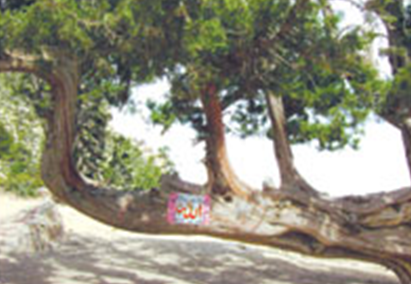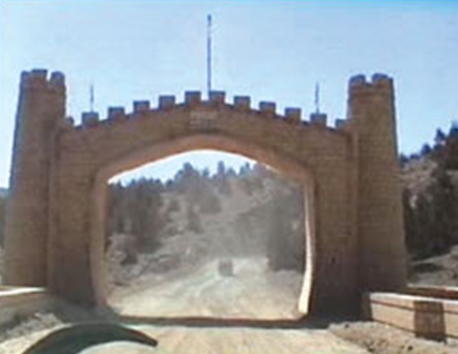Ziarat, Balochistan
This is a collection of articles archived for the excellence of their content. Readers will be able to edit existing articles and post new articles directly |
Ziarat, Balochistan
A trip to the jewel of Balochistan: Ziarat
Text and photos by Syeda Rumana Mehdi
Pakistan is a country well-known all over the world for its scenic beauty and historical places. Born and lived for all these years in the city of Quaid-i-Azam, Karachi, I always longed to visit Ziarat in Balochistan — the city where the Quaid rested during the last days of his life. In fact, visiting Ziarat was always a dream and this dream came true recently.
Ziarat is a wonderful city. It attracts tourists for being a hill resort, because of its greenery and because of its important landmark: The Quaid-i-Azam Residency.
When we went to Quetta during the summer vacation, I got the opportunity to visit Ziarat. I had read a lot about Ziarat. I had seen the photograph of the building where the Quaid had gone for rest in his last days, with his sister, Fatima Jinnah. It was there where the Quaid received government officials and dignitaries and where he took important decisions. Against the advice of his physician who stayed in the same building with him, he continued to work day and night for the sake of Pakistan. Ziarat always had great attraction for me.
It is a two-hour ride from Quetta to Ziarat by road. At Ziarat, there were numerous hotels, rest houses and important places to visit. So get ready to plunge yourself into Ziarat’s beauty!
Walk Chashma
Ziarat is surrounded by mountains. So we weaved in and out of the mountains many times. Halfway to the Prospect Point, there is a waterfall through which glacial water flows and this water is supplied to all parts of Ziarat. It is popularly known as “Walk Chashma”. It inherits its name from the Colonial times when the British used to walk to the place from their homes and offices. The place is surrounded by Juniper trees. The Chashma is good for the ailing people in particular.
Prospect Point
I can’t find words to tell you about this amazing place. It is almost up above in the sky and you can see the whole of Ziarat below. You can feel the clouds close to you. There is also a tree in Prospect Point whose branches clearly spell Allah in Arabic. You can also see the Juniper trees up here. This area is very beautiful and you feel like going further up. But the higher areas are rather dangerous, otherwise these areas are worth visiting.
Quaid-i-Azam Residency
This is the house where the founder of Pakistan spent his last days. The residency is surrounded by green gardens. A guide gives the visitors a tour of the place. He tells the visitors about the living rooms of the Quaid-i-Azam and Fatima Jinnah and shows the drawing room and Quaid’s physician’s room. Historically important photographs of the Quaid, his sister and prominent leaders are very neatly placed on the walls. The residency has also preserved the Quaid’s dining table, his bed and other belongings. Apart from a few changes, the residency contains the same furniture and carpets as it had during the Quaid’s stay.
Ziarat — by any standard — is an immensely wonderful city. However, it has some drawbacks. It has historical and natural influence but it clearly lacks proper cultural environment. The Balochi embroidery is famous worldwide, but you don’t find a shred of embroidery in Ziarat. This is also a hill station, but it hasn’t been developed into a major tourist resort.
The roads are not good and transport facilities are not adequate especially for visiting families with modest means. There is a need for buses for tourists in the city and for building up a sort of a bazaar like the one you find in Muree. These facilities may really transform Ziarat into a wonderful tourist resort for visitors from Pakistan and abroad.
Ziarat
Enchanting Ziarat
By Abdul Basit Jasra
Ziarat’s is located 130kilometres north-east of Quetta and is at an altitude of 2.5 thousand metres above sea-level. One special feature of Ziarat is the abundance of juniper trees that can be found in the region. It is said that some of the junipers are as old as 5,000 years. Juniper cedar is found at heights ranging between 2,000 and 3,000 metres above sea-level. Here, natural water springs or heavy snow on the hills help them grow. Otherwise their growth is very slow.
The name Ziarat means ‘shrine’ and it is associated with a local saint, Kharwari Baba, who is believed to have stayed in the valley and blessed it. After his death he was buried here. Whenever you have a chance to visit Ziarat, you should also visit the shrine of Kharwari Baba. It is only 10kms by jeep from Ziarat PTDC Hotel and it takes just half-an-hour to reach the shrine. It is recommended that one should have at least one night’s stay at Ziarat to enjoy the scenery of the region. You will never forget the amazing beauty of the sunset here. If it is not foggy in the morning, you should not miss the opportunity to enjoy the sunrise also. If your friends are sleeping and you are alone, your loneliness will add much to the beauty of this rewarding scene.
One important asset of Ziarat is the Quaid’s Residency. Perhaps it is the one factor that has made Ziarat a prominent place in Pakistan. It is of huge historical importance as the hero of All Indian Muslims, the founder of Pakistan, Quaid-i-Azam Mohammad Ali Jinnah stayed here in the last days of his life. When you first look at the residency, you realise the stature of the Quaid’s personality.
The view from the residency is in complete consonance with the vision and personality of the Quaid. Here, we understand the reason why Ziarat was the Quaid’s favourite place. The relics of the Father of the Nation are reminiscent of those moments of Jinnah’s life. You feel the moment and, perhaps, time stops here and you are able to ‘listen’ to the impressive voice of Mr Jinnah: “I wish you my brethren of Baluchistan, Godspeed and all success in the opening of this new era. May your future be as bright as I have always prayed for and wished it to be. May you all prosper”… “Pakistan Zindabad!”
This residency was built in 1882 by the British. Later the agent to the governor-general used it as his summer headquarters. Now it is revered as the ‘Quaid’s Residency’.
Another tourist attraction of Ziarat is the Prospect Point. Here again the view is striking. The Prospect Point lies at a height of 2,713 metres above sea-level and is at a distance of some 6kms from Ziarat. Though the terrain is difficult, yet vehicles easily access the point. However, a good walk is usually recommended because it doubles the level of enjoyment and fills tourists with passion. Once on the peak, you are taken in by the whistling wind that augments the beauty of poetic feelings when it passes through the forest. Here, the valley is stretched out in zigzag and undulating slopes in front provides such a rewarding scene that you fail to describe its beauty. However, words fail and cameras appear ‘lazy’ in capturing the beauty found in the valley. From a nearby cliff, you can clearly see the highest peak in the region, the Khalefat, which rises as high as 3,487 metres. A small rest house is situated nearby and it is recommended that a tourist, admirer of natural beauty, must spend some hours here.
Another beautiful spot, 10kms from Ziarat, is the Fern Tangi. A small waterfall and water-courses flow down from here. Tangi is the local term used for ‘gorge’ that is a deep narrow valley with steep sides, usually by a river or stream cutting through a hard rock.
A dramatic waterfall cascading down the rocks is the Sandeman Tangi, which is just four kilometres from Bab-i-Ziarat. It is said that the tourists who miss the Sandeman Tangi lose the purpose of their visit to Ziarat.
Travelling from Ziarat to Loralai you reach the Chutair Valley in only 30 minutes. Here again is a rest house in case you want to stay longer.



